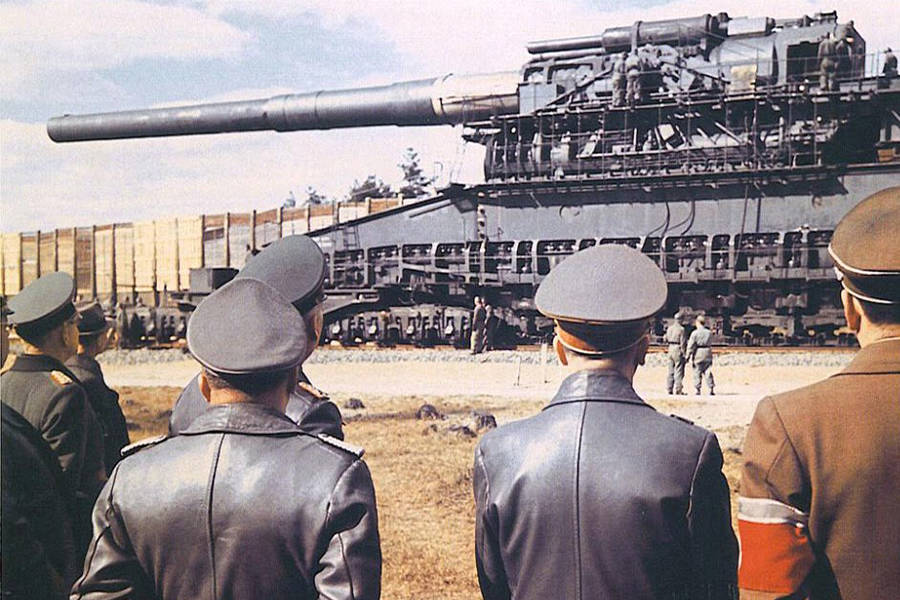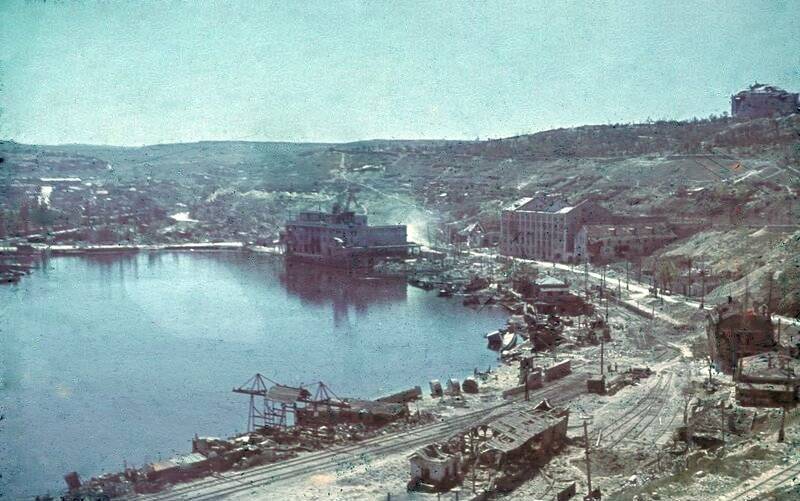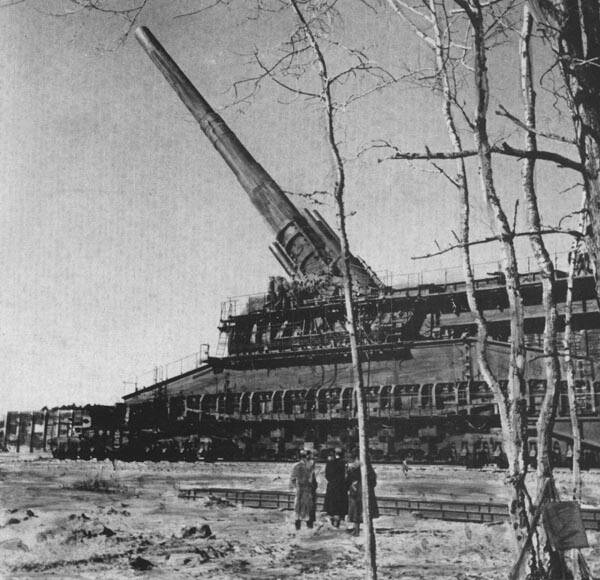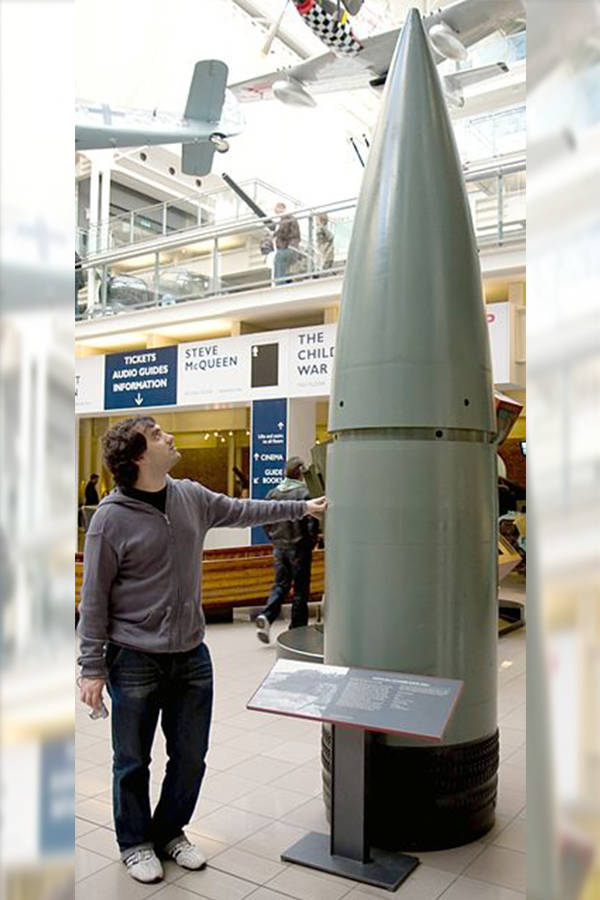Built by Krupp in 1941, the Schwerer Gustav railway gun was the Nazis' "miracle weapon" that could blast through 20 feet of concrete from nearly 30 miles away.
One thing stood before the Nazis — literally — as they prepared to launch war on Europe: France’s Maginot Line. Built in the 1930s, the defensive line stretched for almost 300 miles and included fortresses, gun batteries, bunkers, and minefields. To penetrate it, the Nazis developed a Wunderwaffe (“miracle weapon”) called Schwerer Gustav.
The biggest gun in the world, Schwerer Gustav weighed 1,490 tons and could fire seven-ton shells at targets almost 30 miles away. It probably could have torn the Maginot Line to shreds — if it had been finished in time. The fearsome weapon missed that deadline, but it was used later on in the war.

National WWII MuseumAdolf Hitler and other SS officers inspect the Schwerer Gustav gun.
So what was the Schwerer Gustav gun, the towering railway weapon that required 2,000 men to operate it? How was it used during World War II — and why did it disappear in the middle of the conflict?
The Development Of The Schwerer Gustav Gun
By the 1930s, the concept of super-weapons like the Schwerer Gustav had been around for a while. The Russians built the 39-ton Tsar Cannon in 1586, the British constructed the 47-ton Mallet’s Mortar in 1857, and the Germans unveiled the 47-ton “Big Bertha” in 1914. (Of these three enormous weapons, however, only Big Bertha was used in conflict.)

Public DomainA soldier with a projectile marked “Big Bertha” along with a skull and crossbones. 1918.
By the 1930s, the Nazis started dreaming up a similar weapon that they could use to break through France’s Maginot Line. The gun to do so was designed by Krupp, a steel company based in Essen. Adolf Hitler was interested in its development — he asked about it during a 1936 visit to the company — but developing the gun presented problems.
In order to break through the Maginot Line, the weapon’s shells would have to be powerful enough to smash through 22 feet of reinforced concrete and at least three feet of steel. It would have to be, in other words, a gargantuan weapon unlike anything that had ever been built before.
But Krupp was up to the challenge. Though they missed the deadline to invade France (the Nazis ended up going around the Maginot Line, through Belgium, in May 1940), the Nazis’ new weapon was ready for testing by the end of 1941. It was called Schwerer Gustav, Schwerer meaning “heavier” in German, and Gustav being a nod to Krupp’s former director, Gustav Krupp.
Schwerer Gustav: The Biggest Gun In The World
By the time the Schwerer Gustav was complete at the end of 1941 — it cost 10 million marks to build — it was more like a small building than a gun. From the ground up the Schwerer Gustav was almost four stories tall. The weapon weighed 1,490 tons, and it was 20 feet wide and a 140 feet long.

Public DomainThe Schwerer Gustav had to be transported along railway tracks, which could make concealing its movements difficult.
It had a caliber of 31 inches, and it was able to hit targets roughly 30 miles away. Its barrel alone was nearly 100 feet long, and Popular Mechanics reported in 2004 that it was able to fire two kinds of shells: a 10,584-pound high-explosive shell and a 16,540-pound concrete-piercing shell.
The Schwerer Gustav was so large, in fact, that it required hundreds of men to operate it. (Some sources say 500 men were needed; others claim as many as 2,000.) It took several men just to load the gun’s enormous shells, and the weapon was so large that it could not travel in one piece.
World War II Database explains that the gun was actually transported in five units: the breech ring and block, the barrel split in two halves, the barrel jacket, the cradle, and the trunnions.
Though some sources claim that the Schwerer Gustav was one of two such guns built, World War II Database reports that this is untrue. This misconception likely came from the German artillerymen who mockingly called the weapon “Dora,” leading to the belief that two guns (Schwerer Gustav and Dora) were built. In fact, they may have been one and the same.
Although Schwerer Gustav was not ready in time to breach the French defenses, it was used in battle during World War II.
How The Weapon Was Used During WWII
Though the Schwerer Gustav gun was not used to break through the Maginot Line, the Nazis still wanted to test out their mighty new weapon. In mid-1942, a team of over 1,000 men took three weeks to assemble the gun. Then, it was off to join the siege of Sevastopol.
Between June and July, Schwerer Gustav rained down destruction on the besieged Soviet city. World War II Database reports that it fired about 50 of its shells, one of which purportedly smashed through 100 feet of earth before blowing up an underground Soviet ammunition store.

German Federal ArchivesSevastopol after the siege. July 1942.
By the end of the siege, Sevastopol lay in smoldering ruins. The Axis powers had won a decisive victory.
But the biggest gun in the world may have never been used again.
The German Army transported the mighty weapon to Leningrad (present-day St. Petersburg), but Soviet forces were able to repel the Germans before they could use their new Wunderwaffe. In 1944, it was lugged to Poland for use during the Warsaw Uprising, but the resistance may have been crushed by the time it arrived.
After that, the powerful Nazi weapon vanished from the record.

Public DomainA railway gun in Germany that appears to be the Schwerer Gustav.
It’s unclear exactly what happened to the Schwerer Gustav. It was most likely scrapped by the Nazis sometime in 1944. By then, the super-weapon may have simply posed more problems than advantages.
A Weapon That Was Perhaps Too Powerful

Wikimedia CommonsA single shell was taller than two men, and twice as wide as one.
Though the Schwerer Gustav gun could wreak destruction on its targets, it was, ultimately, an impractical weapon. It required incredible manpower to operate, and during battle, it was hard to spare so many soldiers.
Furthermore, it took the German Army multiple days just to move the giant railway gun. This was hard enough. Moving it covertly was next to impossible. The gun was huge and difficult to hide from planes, which meant that the Allies could track its movements unless the Luftwaffe had total air control.
Finally, maintenance and the cost of shells for the Schwerer Gustav were expensive and hard to justify when there were smaller, more covert tanks readily available.
And so the Schwerer Gustav, the 10-million-mark Nazi dream, disappeared from the battlefield. This Wunderwaffe ended up being less miraculous than the Nazis had hoped. Just three years after it was first deployed in Sevastopol, Germany unconditionally surrendered.
After learning about the Schwerer Gustav, the biggest gun in the world, check out these other astonishing weapons invented by the Nazis. Then, read about the Landkreuzer P. 1000, a German tank so large it couldn’t even be built.





